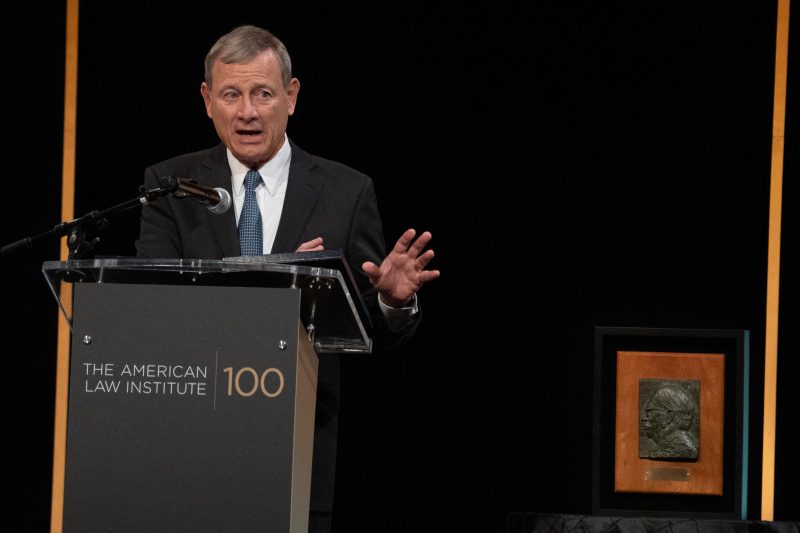The Supreme Court will be tested in the coming weeks to untangle politically consequential legal questions with the potential to reshape the 2024 presidential election. The court’s reputation remains marred by ethics controversies involving lavish travel and gifts, and public approval ratings remain low following high court rulings to overturn long-standing precedent.
But Chief Justice John G. Roberts Jr. did not address any of those contemporary issues Sunday in his annual “Year-end Report on the Federal Judiciary.” Instead, he looked back on technological advancements in the nation’s court system, detailing developments from the quill pens used by justices in the 19th century to electronic databases of the 1980s to online trial proceedings prompted by the coronavirus pandemic.
Roberts, a history buff, also expounded on the potential for artificial intelligence to both enhance and detract from the work of judges, lawyers and litigants. For those who cannot afford a lawyer, he noted, AI could increase access to justice.
“AI obviously has great potential to dramatically increase access to key information for lawyers and non-lawyers alike. But just as it risks invading privacy interests and dehumanizing the law,” Roberts wrote, adding that “machines cannot fully replace key actors in court.”
Public approval of the Supreme Court remains at historically low levels, reflecting a dip that followed its 2022 decision to overturn Roe v. Wade and eliminate the nationwide right to abortion. The court has also faced immense public pressure and criticism following news reports that some justices accepted, but did not disclose, luxury travel funded by billionaire friends.
Roberts also did not mention in his 13-page report the court’s adoption for the first time of a formal code of conduct, announced in November, specific to the nine justices and intended to promote “integrity and impartiality.” For years, the justices said they voluntarily comply with the same ethical guidelines that apply to other federal judges and resisted efforts by Congress to impose a policy on the high court.
But the lack of a code became a persistent complaint from Capitol Hill that the justices were forced to address in 2023. In the weeks before the court’s announcement, several justices said publicly it would be a good idea for the court to embrace its own plan rather than giving Congress an opening to pass a law.
The policy was praised by some as a positive initial step, but criticized by legal ethics experts for giving the justices too much discretion over recusal decisions and for not including a process for holding the justices accountable if they violate their own rules.
Still, Gabe Roth, executive director of Fix the Court, a nonprofit group advocating for court transparency, called 2023 the “most important year for judicial ethics in decades.”
It is “incumbent upon the justices in 2024 not simply to hope that questions surrounding their conduct die out — they won’t — but to make pronounced improvements in transparency and accountability,” he said in a statement before Roberts issued his report.
“That’s especially true since the Court will be deciding such critical issues in the months to come, and it can’t afford to lose any more of the public’s trust.”
Already, the justices have been asked to expedite consideration of a Colorado Supreme Court ruling in December that former president Donald Trump’s name cannot appear on the state’s primary-election ballot because he engaged in insurrection on Jan. 6, 2021. Maine officials have also barred Trump from the state’s primary ballot, putting pressure on the Supreme Court to settle the novel eligibility issue for all states.
Separately, Trump’s claim that he can’t be prosecuted for trying to block Joe Biden’s 2020 victory because he is protected by presidential immunity is expected to make its way to the high court after review in January by an appeals court.
The court’s 6-3 conservative majority includes three justices picked by Trump, but the former president does not have a winning track record at the high court. Some Democratic lawmakers have called on Justice Clarence Thomas to recuse himself from cases involving Trump because of the efforts by his wife, Virginia “Ginni” Thomas, to challenge the 2020 election results.
On top of the Trump-related election matters, the justices are contending this term with high-stakes cases involving guns, the power of federal agencies and the future of free speech online. The court has also agreed to decide this term whether to restrict access to a key medication used in more than half of U.S. abortions.
Roberts used his year-end wrap-up, released by tradition on New Year’s Eve, in part to thank the court system’s technologists and cybersecurity experts. Those experts, he said, keep the judicial branch running behind-the-scenes and answer calls from judges, including Roberts, who said he has “been known to call on help desk staff for urgent and essential assistance.”
Roberts did not mention that this time last year the court was finishing its investigation into the shocking leak of Justice Samuel A. Alito Jr.’s draft opinion that eventually overturned a half-century of abortion rights. The court’s investigative report released last January did not determine the identity of the leaker. While the court’s IT experts did not rule out a hack, the report said there was no evidence to suggest improper access to the court’s IT networks.
In reflecting on technological advancements in the federal court system Sunday, Roberts noted that the legal profession is notoriously averse to change. He emphasized that human judgment will still be required for legal determinations that often involve gray areas. Judges and especially Supreme Court justices face novel, open questions about how the law should develop in new areas — something AI can inform, but not decide, Roberts said.
“Some may wonder whether judges are about to become obsolete,” he wrote. “I am sure we are not—but equally confident that technological changes will continue to transform our work.”


